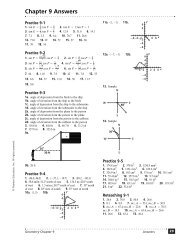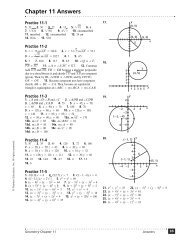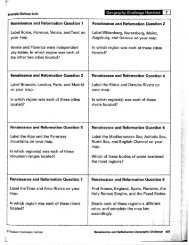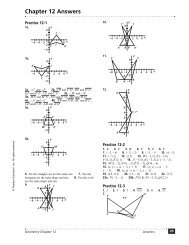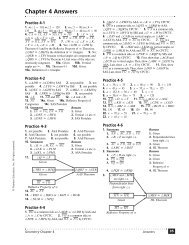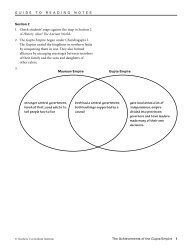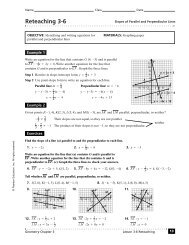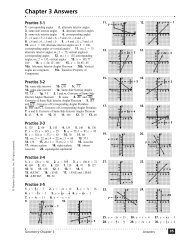Chapter 12 Sequences; Induction; the Binomial Theorem
Chapter 12 Sequences; Induction; the Binomial Theorem
Chapter 12 Sequences; Induction; the Binomial Theorem
Create successful ePaper yourself
Turn your PDF publications into a flip-book with our unique Google optimized e-Paper software.
<strong>Chapter</strong> <strong>12</strong> Test<br />
⎛5⎞ ⎛5⎞ ⎛5⎞ ⎛5⎞ ⎛5⎞ ⎛5⎞<br />
⎜0⎟ ⎜1⎟ ⎜2⎟ ⎜3⎟ ⎜4⎟ ⎜5⎟<br />
⎝ ⎠ ⎝ ⎠ ⎝ ⎠ ⎝ ⎠ ⎝ ⎠ ⎝ ⎠<br />
5 4 3 2<br />
= 243m + 5⋅81m ⋅ 2 + 10⋅27m ⋅ 4 + 10⋅9m ⋅ 8 + 5⋅3m⋅ 16 + 32<br />
5 4 3 2<br />
= 243m + 810m + 1080m + 720m + 240m+<br />
32<br />
5 5 4 3 2 2 3 4 5<br />
13. ( 3m+ 2) = ( 3m) + ( 3m) ( 2) + ( 3m) ( 2) + ( 3m) ( 2) + ( 3m)( 2) + ( 2)<br />
14. First we show that <strong>the</strong> statement holds for n = 1 .<br />
⎛ 1⎞<br />
⎜1+ = 1+ 1=<br />
2<br />
1<br />
⎟<br />
⎝ ⎠<br />
1 1 1 1<br />
The equality is true for n = 1 so Condition I holds. Next we assume that ⎜ ⎛ 1+ 1 1 ... 1 n 1<br />
1<br />
⎟⎜ ⎞⎛ + ⎞⎛ + ⎞ ⎛ + ⎞ = +<br />
2<br />
⎟⎜<br />
3<br />
⎟ ⎜<br />
n<br />
⎟<br />
⎝ ⎠⎝ ⎠⎝ ⎠ ⎝ ⎠<br />
is true for some k, and we show <strong>the</strong> formula <strong>the</strong>n holds for k + 1. We assume that<br />
⎛ 1⎞⎛ 1⎞⎛ 1⎞ ⎛ 1⎞<br />
⎜1+ 1 1 ... 1 k 1<br />
1<br />
⎟⎜ + + + = +<br />
2<br />
⎟⎜<br />
3<br />
⎟ ⎜<br />
k<br />
⎟ . Now we need to show that<br />
⎝ ⎠⎝ ⎠⎝ ⎠ ⎝ ⎠<br />
⎛ 1⎞⎛ 1⎞⎛ 1⎞ ⎛ 1⎞⎛ 1 ⎞<br />
⎜1+ 1 1 ... 1 1 ( k 1)<br />
1 k 2<br />
1<br />
⎟⎜ +<br />
2<br />
⎟⎜ + + + = + + = +<br />
3<br />
⎟ ⎜<br />
k<br />
⎟⎜<br />
k+<br />
1<br />
⎟<br />
.<br />
⎝ ⎠⎝ ⎠⎝ ⎠ ⎝ ⎠⎝ ⎠<br />
We do this as follows:<br />
⎛ 1⎞⎛ 1⎞⎛ 1⎞ ⎛ 1⎞⎛ 1 ⎞ ⎡⎛ 1⎞⎛ 1⎞⎛ 1⎞ ⎛ 1⎞⎤⎛ 1 ⎞<br />
⎜1+ 1 1 ... 1 1 1 1 1 ... 1 1<br />
1<br />
⎟⎜ +<br />
2<br />
⎟⎜ +<br />
3<br />
⎟ ⎜ +<br />
k<br />
⎟⎜ +<br />
k 1<br />
⎟ = ⎜ +<br />
1<br />
⎟⎜ +<br />
2<br />
⎟⎜ +<br />
3<br />
⎟ ⎜ +<br />
k<br />
⎟ ⎜ +<br />
k 1<br />
⎟<br />
⎝ ⎠⎝ ⎠⎝ ⎠ ⎝ ⎠⎝ + ⎠<br />
⎢<br />
⎥<br />
⎣⎝ ⎠⎝ ⎠⎝ ⎠ ⎝ ⎠⎦⎝ + ⎠<br />
⎛ 1 ⎞<br />
= ( k + 1)<br />
⎜1 + (using <strong>the</strong> induction assumption)<br />
k 1<br />
⎟<br />
⎝ + ⎠<br />
1<br />
= ( k+ 1) ⋅ 1+ ( k+ 1)<br />
⋅<br />
k + 1<br />
= k + 1+<br />
1<br />
= k + 2<br />
Condition II also holds. Thus, formula holds true for all natural numbers.<br />
_________________________________________________________________________________________________<br />
15. The yearly values of <strong>the</strong> Durango form a<br />
geometric sequence with first term a 1 = 31,000<br />
and common ratio r = 0.85 (which represents a<br />
15% loss in value).<br />
1<br />
a 31,000 ( 0.85)<br />
n −<br />
n = ⋅<br />
The nth term of <strong>the</strong> sequence represents <strong>the</strong><br />
value of <strong>the</strong> Durango at <strong>the</strong> beginning of <strong>the</strong> nth<br />
year. Since we want to know <strong>the</strong> value after 10<br />
years, we are looking for <strong>the</strong> 11 th term of <strong>the</strong><br />
sequence. That is, <strong>the</strong> value of <strong>the</strong> Durango at <strong>the</strong><br />
beginning of <strong>the</strong> 11 th year.<br />
11 1<br />
a ( ) 10<br />
11 = a1 ⋅ r − = 31,000 ⋅ 0.85 = 6,103.11<br />
After 10 years, <strong>the</strong> Durango will be worth<br />
$6,103.11.<br />
16. The weights for each set form an arithmetic<br />
sequence with first term a 1 = 100 and common<br />
difference d = 30 . If we imagine <strong>the</strong> weightlifter<br />
only performed one repetition per set, <strong>the</strong> total<br />
weight lifted in 5 sets would be <strong>the</strong> sum of <strong>the</strong><br />
first five terms of <strong>the</strong> sequence.<br />
an<br />
= a1<br />
+ ( n−1)<br />
d<br />
a5<br />
= 100 + ( 5 − 1)( 30) = 100 + 4( 30)<br />
= 220<br />
n<br />
Sn<br />
= ( a+<br />
an)<br />
2<br />
S 5<br />
5 = ( 100 + 220) = 5<br />
2 2( 320)<br />
= 800<br />
Since he performs 10 repetitions in each set, we<br />
multiply <strong>the</strong> sum by 10 to obtain <strong>the</strong> total weight<br />
lifted.<br />
10( 800)<br />
= 8000<br />
The weightlifter will have lifted a total of 8000<br />
pounds after 5 sets.<br />
<strong>12</strong>83<br />
© 2009 Pearson Education, Inc., Upper Saddle River, NJ. All rights reserved. This material is protected under all copyright laws as <strong>the</strong>y currently<br />
exist. No portion of this material may be reproduced, in any form or by any means, without permission in writing from <strong>the</strong> publisher.





